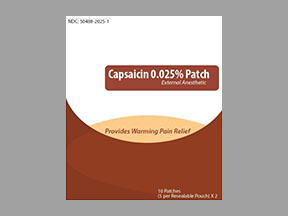
Capsaicin Heat Patch Coupons & Savings Card – Discount Prices from $17.77
Brand for: Capsaicin
My prescription
Edit
0.025%, Capsaicin (30 Patches)
Select pharmacy

CVS
$37.43
COUPON PRICE
Walgreens
$17.77
COUPON PRICE
Albertsons
$31.94
COUPON PRICE
Walmart
$1272.40
COUPON PRICEFree Capsaicin Heat Patch Savings Card

Walgreens
$17.77
Show this coupon to your pharmacist
ID
LHEU254621
PCN
GDC
BIN
015995
GRP
GDRX
This coupon is not insurance
More prescriptions for pain
More prescriptions for pain
Price history for Capsaicin Heat Patch (brand) & Capsaicin (generic)
30 Patches, 0.025%
Average retail price for Capsaicin Heat Patch
Average retail price for Capsaicin
Average SaveHealth price for Capsaicin
Our price history data is based on aggregated prescription data collected from participating pharmacies in America. Our prescription data updates daily to reflect the latest price changes. If you notice a missing data point, it means there wasn't sufficient data available to generate a monetary value for that date.
Over the last 12 months, the average discount price of Capsaicin Heat Patch is $166.87 using the SaveHealth savings card. That's an average savings of -13.52% on Capsaicin Heat Patch with our discount card.
*Retail prices are based on pharmacy claims data, and may not be accurate when we don't have enough claims.
Capsaicin Heat Patch (Capsaicin) dosage forms
Dosage Quantity Price from Per unit 0.025% 30 Patches $54.30 $1.81 0.025% 60 Patches $99.60 $1.66 0.025% 90 Patches $144.90 $1.61
| Dosage | Quantity | Price from | Per unit |
|---|---|---|---|
| 0.025% | 30 Patches | $54.30 | $1.81 |
| 0.025% | 60 Patches | $99.60 | $1.66 |
| 0.025% | 90 Patches | $144.90 | $1.61 |
Capsaicin Heat Patch Warnings
Capsaicin Heat Patch Side Effects
When using this medication, you might experience some mild side effects such as warmth, stinging, or burning at the application site. These effects are generally not a cause for concern, but if they persist or worsen, it is advisable to seek medical advice. Additionally, be cautious to avoid inhaling any dried residue from the medication, as this may lead to coughing, sneezing, watery eyes, or throat irritation. While most people do not encounter serious side effects, it is important to be aware of them. If you experience blistering or swelling at the application site, or if there is increased or unusual pain, discontinue use and consult a healthcare professional immediately. Although rare, severe allergic reactions can occur. Seek emergency medical attention if you notice symptoms such as rash, itching or swelling, particularly on the face, tongue, or throat, severe dizziness, or difficulty breathing. Remember, this list does not cover all potential side effects. If you experience any other unexpected reactions, it is crucial to discuss them with your healthcare provider. Your safety and well-being are of utmost importance, so do not hesitate to reach out for medical guidance as needed.
Capsaicin Heat Patch Interactions
Who should not use capsaicin patches?
Capsaicin patches should not be used by individuals who are allergic to capsaicin or any of the ingredients in the patch. They should also be avoided by those with broken, irritated, or infected skin in the area where the patch would be applied. Additionally, individuals with certain medical conditions or those who are pregnant or breastfeeding should consult a healthcare provider before using capsaicin patches.
Do capsaicin patches work?
Capsaicin patches can be effective for some individuals in managing certain types of pain, such as neuropathic pain or pain associated with conditions like arthritis. They work by desensitizing sensory neurons and reducing the sensation of pain over time. However, effectiveness can vary from person to person, and it may take several applications to notice significant relief. It is important for individuals to follow the application instructions and consult with a healthcare provider to determine if capsaicin patches are appropriate for their specific condition.
Which is better, lidocaine or capsaicin?
The choice between lidocaine and capsaicin depends on the specific condition being treated and the individual's response to each medication. Lidocaine is typically used for its numbing effect to relieve pain in localized areas, while capsaicin is used to reduce pain by decreasing the amount of substance P, a chemical that transmits pain signals. A healthcare provider can help determine which is more appropriate based on the patient's symptoms and medical history.
Are capsicum patches safe?
Capsicum patches are generally considered safe for most people when used as directed. They contain capsaicin, which can cause a warming or burning sensation on the skin. Some individuals may experience skin irritation or allergic reactions. It is important to follow the instructions on the packaging and consult a healthcare professional if there are any concerns, especially if the person has sensitive skin or is using other medications.
What are the side effects of capsaicin patches?
Capsaicin patches can cause several side effects. Common side effects include localized skin reactions such as redness, burning, stinging, or itching at the application site. Some individuals may experience swelling or dryness of the skin. Less commonly, users might experience coughing, sneezing, or throat irritation if they inhale capsaicin particles. It is important to follow the application instructions carefully and consult a healthcare provider if severe or persistent side effects occur.
